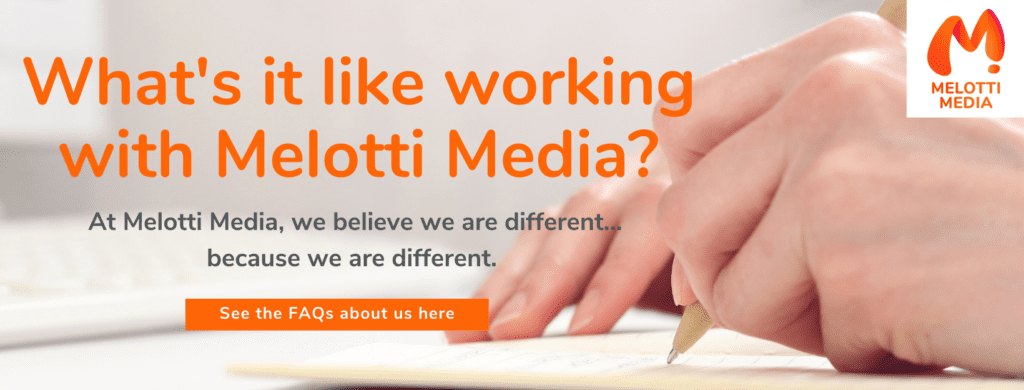
Written by the The Melotti Media Team, checked by Christopher Melotti
Prefer to listen, rather than read? Here's the Podcast summary!
Today’s world is buzzing with technological advancements and business expansion.
From social media to machine learning and AI, it seems like the next big revolution in business and marketing is always just days away.
As Bill Gates so eloquently puts it: “The internet is becoming the town square for the global village of tomorrow”.
But as more and more business brands are created and the so-called “town square” becomes increasingly full, two things become true for your customers:
- More Options, and
- Less Clarity
Amidst this chaos, customers are craving an antidote to the overwhelming and increasingly vanilla noise of the market.
They’re craving uniqueness and through that uniqueness, trust.
So, how can you give it to them?
With a well-crafted Brand Messaging Strategy!
Often, companies limit their communications strategies and brand guidelines to fonts, colours and moods – which is a great start. However, the heartbeat of your brand isn’t in pixels, products or pricing…
The true heartbeat of your band lies in the message that you convey to your ideal customers; “here’s who we are and why you need us”.

At Melotti Media, we understand the power of brand messaging and see the transformative impact that an effective marketing strategy has on our happy clients every single day.
That’s why we’ve decided to create this Complete Guide to Crafting an Effective Brand Messaging Strategy for powerful corporate communications.
To those who read on
We’ll:
- unravel the secrets of how to build a Brand Messaging Strategy that embraces the essence of your brand and captivates your ideal audience.
- delve into the art and science of effective messaging, pouring out everything that we know in a vibrant, uncomplicated, and impactful way so that you can adopt our methods and enjoy the Messaging Strategy you deserve.
Together, let’s ensure that your brand’s message isn’t just heard; it’s absorbed, adored and remembered.

Contents:
Chapter 1: Introduction to Brand Messaging Strategy

What is a Brand Messaging Strategy?
To keep your brand at the forefront of the market, you need to articulate a clear identifying corporate message that resonates with your ideal customers.
Like it or not, your customers will interpret the value of your business in their minds based on a set of impressions, feelings and perceptions – a business Brand Messaging Strategy ensures that you don’t leave this up to chance.
It’s about crystalising the culture and the personality of your organisation, so your customers don’t rely on assumptions to interpret your value.
Think about it…
- When Apple says, “Think different” you feel inspired to be a trendsetter.
- When Nike says, “Just do it” you’re energised and motivated to get active.
- When Subway says, “Eat fresh” you may choose it over a less fresh competitor.
The world’s top brands understand the importance of brand messaging.
They recognise that crafting consistent corporate messages that resonate with your target audience, conveys not just what your product or service is, but more importantly why it matters.
So if it’s good enough for them, it’s good enough for us, right?

The Impact of a Brand Messaging Strategy
A Brand Messaging Strategy isn’t just about putting a clever slogan together – that might be part of it – but it’s a lot more extensive and valuable than that.
A Corporate Brand Messaging Strategy is about establishing a set of messaging guidelines to direct EVERYTHING that your brand says across all its channels.
More than just a tagline or two, a Brand Messaging Strategy encapsulates the essence of your brand, aligning it with the aspirations and needs of your audience.
The best part is that the more you apply your brand strategy, the more meaningful connections you can create with your customers and the more long-term brand loyalty you can foster.
As was made clear by the previous real-world examples, strong brand messages shape the way your audience perceives your brand. It influences their:
- beliefs,
- attitudes,
- emotions, and
- and purchasing decisions.
That’s why a well-crafted message builds trust and differentiates your brand in a crowded market.
With the right brand message, people value your business for more than just what it offers but instead for how it makes them feel.
Conversely, inconsistent or unclear brand messaging can lead to confusion, erode trust, and hinder the perceived quality of your business (regardless of its actual quality).
So, to avoid undoing all of your hard work behind the scenes of your business, here’s what you’ll learn moving forward:
- How to identify and target your audience and objective,
- How to develop your Messaging Strategy and a consistent tone of voice,
- How to implement your strategy, ensuring it’s feedback-driven and has the right level of storytelling and emotional appeal,
- The legal and ethical considerations of message marketing, and finally,
- Some important forecasts and trends to keep an eye on
In the brand messaging guide chapters that follow, we aim to equip you with the tools to craft an effective Messaging Strategy.
So, let’s get into it!

Chapter 2: Understanding Your Audience
Precise identification and segmentation of your target audience is fundamental to an effective Brand Messaging Strategy.
Ask yourself: who am I trying to reach with my brand message?
The key is to be as specific as possible.
While the makeup of your audience will depend upon the nature of your business, here are some examples:
- Buyers Agents targeting first-time home buyers.
- Business Coaches targeting new businesses and start-ups.
- Chiropractors targeting busy working professionals.
Ultimately, by segmenting your ideal audience you’re no longer preaching to the masses – instead, you can speak to your ideal customer as if they were one person.
This makes brand messaging more powerful and accurate.
The Importance of Understanding Audience Needs and Preferences
Whoever you decide your ideal customer is, it’s worthwhile to gather some basic data on their wants, needs and preferences.
By understanding the characteristics of your audience, you can tailor your Brand Messaging Strategy to resonate with your ideal customer and ensure your communication is both targeted and impactful.
In other words, by having a very specific archetype of your ideal customer, you can address them directly and speak to their specific dreams and pain points.
This insight enables the creation of brand messages that directly address their concerns and therefore demonstrate the value and relevance of your brand.
When your audience feels both heard and spoken to, this fosters a sense of brand connection and loyalty, driving greater engagement and conversion.
The question is, where can you gather this sort of customer information and data?

Methods for Audience Brand Research and Analysis
Audience research and analysis are vital components of a successful Message Marketing Strategy.
We suggest you employ a mix of both quantitative and qualitative methods, such as:
- surveys,
- interviews,
- customer feedback,
- social media interactions, and
- Google Analytics or other market research software.
But importantly, this isn’t a set-and-forget approach – your Brand Messaging Strategy is meant to be a living, breathing, dynamic concept!
By continuing to gather data and further understand your audience’s behaviour and sentiments, you’ll be empowered to adapt your Brand’s Messaging Strategy in real time and align your business’ message with evolving consumer trends and preferences.
But more on that to come.

Chapter 3: Establishing Clear Objectives
Gaining a clear understanding of your audience is one of many objectives that needs to be established before developing your Brand’s Messaging Strategy.
It’s also important to define what success looks like for your messaging efforts – whether that’s:
- increased brand awareness,
- higher conversion rates, or
- enhanced customer engagement.
The key is to ensure that the goals you set are tangible, meaning they are both
- specific, and
- measurable
For instance, “We aim to achieve an XX% increase in social media engagement” or “We aim to achieve an XX% increase in website traffic”.
Ultimately, this clarity facilitates a data-driven approach to assessing your success and refining your goals for the future.
Aligning Your Brand Messaging Objectives with Your Overall Business Goals
Effective messaging helps you meet broader business objectives.
This means that your messaging should not just align with, but explicitly state the vision, mission and purpose of your company.
- If you aim to become the market leader, your messaging your be targeted toward building authority.
- If you want to position yourself as a disruptor, your messaging should be contrarian and innovative.
The goal of messaging guidelines is to create a cohesive narrative about your brand that reinforces its identity so that your customers aren’t left to interpret it themselves.
Red Bull Case Study
Red Bull is the perfect example of this approach.
To remain the market leader in energy drinks, its brand message marketing crafts an inspiring narrative of limitless energy and adventure in the minds of its customers.
By associating the brand with extreme sports, daring stunts, and cleverly stating that “Red Bull gives you wiiings” it sells a lifestyle and fosters a high-energy message that resonates with its target audience perfectly.
So, quickly grab a Red Bull (or coffee) and let’s dive deeper!

Chapter 4: Developing Your Brand Core Message
When developing your Brand Messaging Strategy, the goal is to be as compelling as possible.
You want to “compel” your ideal customers to:
- Notice,
- Engage, and
- Recommend
your business as often as possible.
The best way to do this is to use your unique messaging to communicate your brand's values and mission; the how and why you do what you do.
A cohesive corporate message about the values of your business and the mission that defines you is key to establishing authenticity and it becomes a powerful expression of your brand’s identity. If created strategically, it is also a highly effective way to build rapport and resonate with your ideal customers who are likely inspired by and drawn toward those same values.
Reinforcing the true essence of your brand is key to creating a genuine connection with your audience and attracting like-minded consumers, however, there are two more ingredients you need to add when developing your Core Message…
A Clear and Concise Message is a Compelling Message
We’ve got a question for you…
What makes something memorable and relatable?
What makes something recognisable and significant?
- Clarity.
- Consistency.
Why?
When you’re clear in your brand message, there is no confusion about the essence of your brand and when there’s consistency, your audience receives a coherent and reliable narrative, reinforcing your brand’s value across multiple touchpoints.
In a world inundated with information, a message that has these characteristics will quickly cut through the noise, capture your audience’s attention and foster understanding.
So, how can you ensure that you tick all these boxes when developing your core message?
Introducing the Brand Core Messaging Document©
Melotti Media’s Core Brand Messaging Document enshrines a reliable set of brand guidelines that act as a starting point for all your marketing messages.
Think of it as a spiel of on-brand messages around how your business talks and the style in which it communicates.
Once you have developed your brand’s core marketing messages, you can then use them to conceptualise and formulate marketing campaigns and produce clear and consistent content that remains in line with your Messaging Strategy both today and into the future.

Chapter 5: Tone of Voice Consistency
Having core brand message guidelines doesn’t just allow you to communicate your brand’s values, vision, mission and purpose but also helps to establish a clear tone of voice for your brand.
A clear and consistent tone of voice helps you establish a brand that's unique and easily recognised by your audience.
Think of tone of voice as how your brand talks, and how it sounds to your customers. It could be:
- Formal and Professional (e.g for accountants and lawyers)
- Conversational and Friendly (e.g for marketers and event planners)
- Humorous and Witty (e.g for personal trainers and speakers)
- Empathetic and Compassionate (e.g aged care providers and medical professionals)
- Innovative and Cutting-Edge (e.g SaaS companies and start-ups)
Picture it this way: if you’re a divorce lawyer, it’s hard to build rapport if you’re overly humorous or witty, equally, no one wants a personal trainer who isn’t energetic and isn’t going to inspire them to work hard.
Sure, there are times when your tone of voice is completely different to what people expect, but nevertheless, tone must be deliberate if you want it to work.
In summary: your brand’s tone of voice is how you implant the message behind your business and your brand into your customer's subconscious mind.
The Importance of Tone Of Voice Consistency
When it comes to your brand’s tone of voice, maintaining consistency across all channels is crucial for brand message coherence.
Whether via:
or any other form of marketing and communications, a unified tone of voice builds trust, enhancing brand loyalty.
With a consistent brand tone of voice, your ideal customers will have the same brand experience regardless of where or how they interact with you.
Training Your Team to Use the Correct Tone of Voice
You might be thinking…
“It’s not always me that’s writing or speaking on behalf of the business, so how do I ensure things are always consistent?”
Great question!
As a busy corporate manager or business owner, it’s next to impossible to stay across everything – from keeping a consistent tone of voice to ensuring that the values, vision, mission and purpose of your organisation are always clearly communicated, you may feel overwhelmed.
So, how can you ensure that your team know how to communicate your brand’s message in your absence?
Enter again, your Core Brand Messaging Document.
Acting as your brand’s messaging guidelines, this document will empower your team to first understand and then communicate your brand’s message.
Think of this document as an evergreen brand blueprint that should be visible at all times and guide your team to be consistent in all that they say and do on your marketing and communication channels. .

Chapter 6: Channel Strategy and Content Creation
Ok, great – you’ve developed your Brand Messaging Strategy.
Now it’s time for the fun part: implementation!
It all starts by first choosing the right channels to distribute your message.
Choosing the Right Channels to Distribute Your Brand Message
In the digital age, there is an endless array of channels to choose from when it comes to business’ message marketing.
While we have our preferences, all it really comes down to is where your target customers are most active (that’s why customer segmentation is so vital).
Ask yourself (and the data), where are your customers spending their time the most?
Is it:
The ultimate goal is to present your brand message on as many channels that allow you to amplify your brand as possible.
It’s all about getting eyeballs on your brand!

Tailoring Your Brand Message
Remember when we explained the importance of sticking to your brand guidelines?
Well, nothing has changed.
However, you will need to adapt the implementation of your business message to suit each platform’s unique dynamics.
To be clear, this doesn’t mean you change your message - clarity and consistency are still vital. .
It means that you simply tailor the format of your message – for example turning your written website blog into a spoken social media video – it’s the same message, just a different means of presentation.
Tailoring your message in this way ensures that you resonate with your unique audience on multiple levels while remaining clear and consistent.
Sound challenging?
Here’s some branding tips:
Best Practices for Creating Engaging and Relevant Content
Crafting compelling brand message marketing content involves understanding your audience’s preferences, paint points and dream points.
- What problems do they need to be solved?
- What dreams can you help them achieve?
A great way to frame your content creation is to think of your job as solving problems.
Ask yourself, “How can I build as much goodwill in my audience as possible?”
Ultimately, by consistently producing relevant and engaging content that clearly expresses your brand message, you will deepen audience connections and enhance your brand's influence and recognition. .
Pro Tip: stay on top of recent trends that might boost your engagement and encourage audiences to connect with you and your team through calls to action.

Chapter 7: Incorporating Storytelling and Emotional Appeal
Humans have been drawn to stories since the dawn of time.
This is no different when comes to brands and message marketing.
Storytelling marketing serves as the lifeblood of compelling messaging as it moves beyond the mere transmission of information to create an emotional connection with your audience. .
This emotional resonance is the spark for a memorable brand narrative that remains in the minds of your audience encouraging them to build a lasting connection with your brand and perhaps even become a part of your brand’s compelling story.
Put simply, storytelling turns an otherwise transactional exchange into a shared journey.
Take the toiletries company Dove for example.

Their “Real Beauty” campaign masterfully employed storytelling by showcasing the stories of diverse women and challenging traditional beauty standards.
By weaving in various brand narratives of individual struggles and triumphs, Dove didn’t just sell their product, they championed a broader story that resonated with their message of beauty and acceptance.
But storytelling isn’t the only way to generate emotional appeal in your marketing…
Brand Techniques for Creating Emotional Connections
- Empathy and Understanding
A great way to demonstrate a genuine understanding of your audience’s needs, challenges, and aspirations and therefore foster a sense of connection is to take an empathetic approach to your messaging content. In other words, put yourself in your audience’s shoes and create marketing content that answers the common concerns and questions of your ideal customer.
- Personalisation
Another great way to foster an emotional connection with your audience is to personalise your brand messaging. This might be as simple as adding audience qualifiers like “Are you a busy professional?” or even addressing customers by their names in email marketing campaigns.
- Humour, Wit and Personality
Injecting a level of humour, wit or personality into your message can create a positive emotional experience. Of course, how you use this is context-dependent, but no one wants to read a Wikipedia page – your message marketing should be captivating!
Just like this article, right!? 😉

Chapter 8: Feedback, Measurement, and Adaptation
“Feedback is the breakfast of Champions” – Ken Blanchard (Author and Businessman)
Sorry, Weet-Bix but he’s right.
The key to ensuring that your Corporate Messaging Strategy isn’t just effective in the short term but continues to bear fruit for years to come is through constant feedback. .
And once you eat the breakfast of champions, how about lunch and dinner? Or as we like to call it – measurement and adaptation.
But first, let’s take a look at feedback.
How to Gather and Use Feedback to Improve Your Brand Messaging
Understanding how your target audience perceives your message is essential.
It’s how you ensure that your Messaging strategy is resonating.
Beyond reaching out to your customers and audience members one-on-one, other great ways to gather messaging feedback include:
- surveys,
- focus groups, and
- monitoring social media comments.
Once gathered, this qualitative information will offer valuable insights into the experiences of your audience and allow you to make informed decisions about the tone, content, and delivery of your messages moving forward.

Key Performance Indicators (KPIs) for Messaging Effectiveness
Beyond feedback, the success of your Brand’s Messaging Strategy hinges on how well you can measure your performance.
To start this process, we suggest you establish some basic Key Performance Indicators (KPIs).
Metrics like:
- click-through rates,
- engagement rates,
- conversion rates,
- impressions,
and so many others provide quantitative insights into how well your Messaging Strategy is performing.
In this way, KPIs serve as a guide for data-driven decision-making, ensuring that your Messaging Strategy aligns with your overarching goals and objectives.
Adaptation: Refining Your Brand Strategy Based on Feedback and Results
Feedback and KPIs are valuable tools for understanding the basics:
- What’s working, and
- What isn’t working.
From here, you have all the information you need to refine and adapt your Corporate Messaging Strategy.
Remember when we said your Core Brand Messaging Document wasn’t meant to be set in stone?
Well, this is where those changes are made.
By embracing a feedback-driven and data-driven approach, you can continually improve your Messaging Strategy for continuous improvement and enhanced audience engagement.

Chapter 9: Legal and Ethical Considerations of Branding
When it comes to your Brand Messaging Strategy, maintaining a positive and ethical approach is paramount, not just to preserve your reputation with your customers but also to ensure that you are legally compliant.
So, although we marketers like to get a little crazy sometimes… you must ensure all of your messaging and communications adhere to the legal boundaries and ethical standards of your jurisdiction.
A bad brand reputation is very hard to repair, and prevention is better than cure. .
So, ensure your messaging takes into account all of these factors as well.
Australian Compliance and Regulators
Australia’s marketing (and therefore messaging) landscape is overseen by key regulators to ensure fair and best practices are always upheld.
The key regulators you should be aware of are:
- The Australian Association of National Advertisers (ANA), which sets industry standards and emphasises ethical and responsible advertising practices, and
- The Australian Competition and Consumer Commission (ACCC), which monitors advertising to prevent misleading or deceptive conduct.
Compliance with these regulators and any other Australian marketing regulations is key to promoting transparency, safeguarding consumer rights, and fostering a trustworthy marketing environment.
While we recommend that you look into the specific laws and rules yourself or with a trusted legal advisor, a good rule of thumb when it comes to your messaging is to:
- be transparent,
- avoid deceptive practices,
- respect privacy and confidentiality,
But of course, we are not legal advisors, and this should not be taken as legal advice.
When developing something as important as your brand’s messaging strategy, don’t forget to run it by your legal team and have multiple people with different perspectives review it too. They may spot issues that you don’t.

Chapter 10: Conclusion and Future Branding Trends
So… that’s all folks! You made it!
We trust you now know everything there is to know about crafting an effective brand marketing strategy.
A well-crafted Messaging Strategy is the heartbeat of your brand. It’s how you resonate with your audience, foster trust and ultimately attract and retain your ideal customer!
So, this investment in your time reading this ultimate guide to brand messaging strategy was worth it!
Key brand strategy takeaways
As we wrap up this comprehensive guide, let’s reflect on some key takeaways.
- Firstly, understanding your audience and your objectives is essential to crafting corporate messages that are purpose-driven and resonate with customers.
- Secondly, when developing a compelling Core Message, a Core Brand Messaging Document should be the nucleus of your strategy, outlining your tone of voice, vision, mission, purpose and values.
- Then, in the brand implementation phase, ensure you select the right message marketing channels and tailor your message with storytelling and emotional appeal.
- Lastly, seek constant messaging feedback, measure your results and adapt your approach for sustained success – and don’t forget to remain ethical and compliant!
Emerging Trends in Messaging Strategy
Looking ahead, it’s always important to keep an eye on emerging trends in the message marketing space.
So embrace new technologies like AI, explore innovative content formats, and stay attuned to the evolving needs of your audience. As the marketing landscape evolves, your adaptability will be the key to ongoing success.
To stay on top of all this and more, take a look at our Melotti Media blog!
Otherwise…
Are you looking for help to craft your Brand Messaging Strategy?
It would be best to get a team of branding professionals and expert copywriters by your side.
An expert branding copywriter can translate your brand’s vision and direction into words that will not only resonate well with your audience but also inspire them to engage with your business.
In other words, an expert message marketing copywriter does everything that you’ve learned today and more!
Our Core Messaging Strategy Services
At Melotti Media, our Core Brand Messaging Services start with a one-off session to develop an effective strategy.
It’s all about getting to know you and your organisation, truly!
We will take the time to sit down with you and listen to your unique communication needs and objectives.
With our extensive background in marketing, we take the time to understand your business and then construct a comprehensive Core Brand Messaging Document that’s aligned with your identity and that you can use as your core messaging guide. In essence, we put your brand message into words strategically so that your customers feel more aligned with your businesses and more inclined to engage.
Great! You’re all set…
Unless of course, you’d prefer a strategic communications professional to assist you with messaging implementation as well!
Again, we can help…
your business with everything from developing a strategic content marketing framework to writing your message marketing content as well.

How can Melotti Media help you with your Messaging Strategy?
To stand out in today’s crowded business environment and to inspire innovation and action, you need to design and implement your message marketing content strategically. However, we understand that this is easier said than done.
You’re time-poor and spread thin, and message marketing may not be your expertise. So, focus on what matters, while we take care of all of your content marketing needs.
For more information or to speak to our expert brand messaging team, contact Melotti Media today:
enquire@melottimedia.com.au










